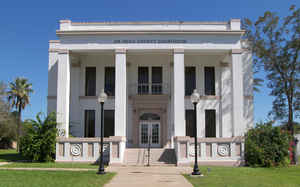Texas Counties
Texas is divided into two hundred and fifty-four counties, more than any other state. Texas was originally divided into municipalities, a unit of local government under Spanish and Mexican rule. When the Republic of Texas gained its independence in 1836, there were 23 municipalities, which became the original Texas counties. Many of these would later be divided into new counties. The most recent county to be created was Kenedy County in 1921. The most recent county to be organized was Loving County in 1931Jim Hogg County, Texas
Jim Hogg County Education, Geography, and History

Jim Hogg County is a county located in the state of Texas. Based on the 2010 census, the population was 5,300. Its county seat is Hebbronville. The county is named for James Stephen Hogg, the governor of Texas from 1891 to 1895.
Etymology - Origin of Jim Hogg County Name
James Stephen Hogg, the twentieth governor of Texas
Demographics:
County QuickFacts: CensusBureau Quick Facts
Jim Hogg County History
JJim Hogg County was formed in 1913 from portions of Brooks and Duval counties. It was named after Jim Hogg, the 21st Governor of Texas, and the first governor born in the state of Texas.. Its county seat is Hebbronville.
Handbook of Texas Online
Immediately after the end of the Mexican War all of the land in the disputed territory was officially made part
of the state of Texas. At various times the area that is now known as Jim Hogg County was under the jurisdiction of
Brooks, Duval, Starr, Zapata, Live Oak, and Hidalgo counties. When Duval County was organized in 1875 it included
what is now Jim Hogg, Jim Wells, and Brooks counties. Part of the area was included in Brooks County when it was
formed in 1911, but in 1913, in an effort to free themselves from the political dominance of Edward C. Lasater,
D. D. David, Reuben Holbein, Oscar Thompson, and A. C. Jones requested from the
state legislature that a county separate from Brooks County be formed. D. W. Glasscock, in his first term as a state
representative, sponsored legislation establishing Jim Hogg County, in order for his constituents "to get out from
under the domination of the Mexican vote at the other end of the county." Advocates of the new county argued that
they were too far removed from Falfurrias, the county seat of Brooks County, a separation that made it difficult for
them and their neighbors to do business. Consequently, Jim Hogg County was formed out of Duval and Brooks counties;
land from Duval County was included so that the town of Hebbronville, with its railroad station, could be in the new
county. Jim Hogg County was organized and established that same year, and elections for county officials were held
in July. At that time the school system was organized, and construction of a county courthouse was started More at
Alicia A. Garza, "JIM HOGG COUNTY," Handbook of Texas Online (http://www.tshaonline.org/handbook/online/articles/hcj06),
accessed January 24, 2016. Uploaded on June 15, 2010. Published by the Texas State Historical Association.
Geography: Land and Water
As reported by the Census Bureau, the county has a total area of 1,136 square miles (2,943 km2), of which,
1,136 square miles (2,943 km2) of it is land and 0 square miles (0 km2) of it (0.00%) is water.
Neighboring Counties
Bordering counties are as follows:
- Duval County (north)
- Brooks County (east)
- Starr County (south)
- Zapata County (west)
- Webb County (northwest)
Education
All of the county is served by the Jim Hogg County Independent School District.
The district has three schools: Hebbronville Elementary School, Hebbronville Junior High School, and Hebbronville High School. All of the
schools are considered to be in the Hebbronville community.







